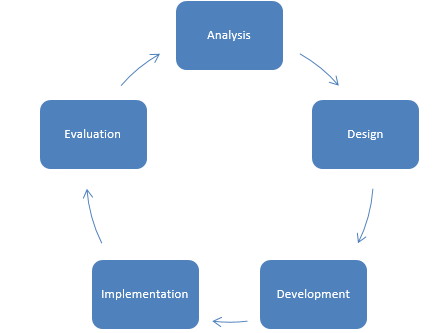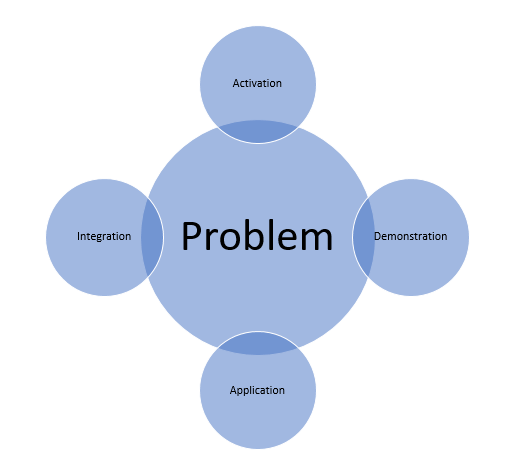Introduction
Instructional design models are crucial for enabling the learning process by allowing the user to comprehend an underlying problem that was initially incomprehensible. The use of appropriate instructional models by operating room tutors can help in conceptualizing an existing problem since the models break down the existing predicament into smaller and more manageable units. A great model bears five key tenets, namely customization to the specific audience, method of delivery, appropriateness, implications, and reliability. The following four instructional design models are appropriate for the operating room in a hospital.
ADDIE Model
The ADDIE model encompasses four phases in its design. It allows the learner to conceptualize the problem throughout the process. These phases include psychotherapy, plan, growth, execution, and assessment. The processes represent changeable instructions for use during teaching and performance assessment. In the evaluation phase, the results are improved before repeating the whole process.
Merrill’s Principle of Instructions Model
Being the first instructional model ever to be designed, Merrill’s Principle of Instructions Model is based on the notion of instilling as much knowledge as possible from each course. David Merrill proposed the model that is based on five key principles, namely the task-centered principle, the principle of activation, the principle of demonstration, the principle of application, and the principle of integration.
Gagne’s Nine Events of Instruction Model
Gagne’s Nine Events of Instruction model consists of an event series that is designed based on the behaviorist theoretical approach to learning. The events form a systematic process of instructional design aimed at adapting to different learning environments. These events can be summarized in nine steps: gaining students’ concentration, informing the learners, encouragement of recall, presentation of content, learner guidance, elicitation of performance, providing feedback, assessing performance, and enhancement of retention and job transfer.
Bloom’s Learning Taxonomy
Bloom’s learning taxonomy model classifies intellectual behavior at different levels of cognitive learning. According to Benjamin Bloom, over 95 percent of examination queries call for students to remember through judgment at the lowest feasible point. Bloom created a design that comprised several phases of cognitive judgment from the straightforward recollection of details or comprehension as the lowest stage to the assessment of particulars at the uppermost stage. He used verb levels to represent the intellectual activity of cognitive thinking for each level. The levels include knowledge, understanding, application, analysis, synthesis, and evaluation. However, the model has been updated to provide relevance to the 21st-century learning design. This new model has been modified to incorporate remembering as the lowest level and creation as the highest level of cognitive performance.
Critical Analysis
The ADDIE Model
Intended Audience
The model is designed to match the skills and intelligence level of each participant. In this regard, the design of the model is programmed to focus on the yet-to-be-explored topics or areas as a way of minimizing the duplication of topics that the learners are already familiar with (Forest, 2014).
Delivery Method
The ADDIE model incorporates an iterative feedback approach to delivering instructions. Hence, according to Welty (2007), the results obtained after the evaluation phase are returned to the loop for a repeat of the process. This process provides an opportunity for further enhancement of the learning process.

In the analysis stage, the instructor identifies the issue/problem, the audiences’ level of knowledge and skills, the needs of the audience, and the goals of the learning process. The design phase includes the incorporation of the different items analyzed during the first phase of the model into the model design. In the development phase, the instructor begins to generate and assess the methodology of the actual plan. In the evaluation phase, the instructor subjects his or her audiences through a final test to know its effectiveness, for instance, its achievement of the set objectives through a formative and summative technique.
Key Learning Theories
The cognitive learning theory describes the interactions between the various mental components and the information that arises from the complex network. Therefore, individuals can create their cognitive phenomena through the related concepts they learn from their experiences.
Implications
According to Rosenberg (2011), the ADDIE model focuses more on the process with little regard for the outcome.
Justification
The model is appropriate in the operating room due to its focus on the audiences’ level of skills and knowledge, a key facet of operational procedures.
Merrill’s Principle of Instructions Model
Intended Audience
According to Merrill (2002), this model is intended for learners who are required to solve particular problems in their learning environment/experience through a process of collaborative engagement.
Delivery Method
The model incorporates four distinct phases in instruction delivery, namely activating prior experiences, demonstrating skills learned, applying the acquired skills, and integrating these skills into the actual real-world problems.

Based on the above illustration, it is clear that the model is based on several principles of effective instruction delivery. The principles include engagement of learners in solving real-world problems, activation of knowledge gained throughout the learning process to set a foundation for gaining more knowledge. The instructor demonstrates how new knowledge is applied before the learner applies new knowledge. The learner is expected to integrate the new knowledge into his professional world.
Key Related Theories
The Star Legacy Theory is in line with Merrill’s Principles of Instructions. It suggests various learning phases where learners interact with other learners to share their experiences. They also compare the problem with multiple solutions. They also do research and revisions through a continuous demonstration and application of knowledge. Students apply their generated ideas with the anticipation of receiving feedback from their tutors.
Implications
Merrill (2002) asserts that the thorough application of this type of model, learners become motivated to learn due to the integration of the instructions provided to demonstrate their improvement in their operational skills while at the same time defending and modifying their newly gained knowledge based on the situations they encounter.
Justification
Through this tool, learners are involved in solving real day-to-day problems they may encounter in the operating room. Also, the model provides learners with the opportunity to demonstrate and improve their operating room skills.
Gagne’s Nine Events of Instruction
Intended Audience
This model is designed for audiences that are involved in harnessing specific instructional events throughout their learning experience to achieve some explicit outcomes. Therefore, this model best fits in a procedural learning environment where the instructor takes the learner through various events of a particular process (Khadjooi, Rostami, & Ishaq, 2011).
Delivery Method
The first stage of this model involves the instructor identifying the various outcomes that are intended to be achieved in the course. These outcomes are categorized as intellectual skills, verbal information, cognition strategies, motor skills, and attitudes. The instructor organizes the instructions into appropriate events that comprise gaining the learner’s attention, informing the audience of the activity’s objective, stimulation of recall of essential information through instructor asking questions, and the learner’s presentation of new content in an organized and meaningful way among others.
Key Related Theories
Similar to Gagne’s theory, constructivist theory regards the learner as the main body of the learning process. The audiences construct knowledge through their initiatives where tutors are the main drive for the student’s knowledge construction (Fosnot, 2005).
Implications
The model has influenced the curriculum of many learning institutions. For instance, tutors now ensure congruency of the learning objectives, skills acquired, the knowledge gained, and experiences throughout the course.
Justification
The model can be effectively applied in giving instructions in the operating room since it allows the learners to relate the objectives of the operation/surgery with the knowledge and skills they have acquired.
Bloom’s Learning Taxonomy
Intended Audience
Bloom’s Learning Taxonomy model is intended for audiences who are required to recall a sizable amount of knowledge, including facts and procedures from their coursework. The model upholds the application of the information appropriately in tackling related and complex tasks.
Delivery Method
The revised model constitutes six levels of cognition, namely remembering, understanding, applying, analyzing, evaluating, and creating. Remembering requires the learners to retrieve relevant information from their long-term memory that they can use for maneuvering through complex tasks. Understanding promotes knowledge retention through the tutor’s construction of meaningful instructions through written, oral, and graphical means of communication. The application involves the use of procedures in the performance of complex tasks that are closely connected to the acquired procedural knowledge.
Psychotherapy involves dividing the information content into meaningful bits and dictating how they are interconnected not only to each other but also to the general composition of learned content. The evaluation level requires the learner to make appropriate judgments using the accepted standards and criteria such as quality, efficiency, constituency, and effectiveness. The element of creation involves engaging the learner in putting together various elements of a procedural task into a functional and coherent whole.
Key Related Theories
The Solo taxonomy theory upholds this model. The theory encourages learners and trainers to understand the process of learning. According to Brabrand and Dahl (2009), it incorporates the following five levels based on the learners’ understanding.
- Pre-structural: The learner fails to understand the subject and uses simple means to perform a task
- Un-structural: The learner focuses on one of the relevant basic aspects of a particular concept
- Multi-structural: The learner focuses on some relevant but interrelated aspects of the concept
- Relational: The learner is required to integrate the different aspects of the concept into a meaningful and coherent whole.
- Extended abstract: The learner creates new ideas according to subject mastery.
Implications
According to Rhalmi (2010), the model helps instructors to classify their content/materials in a meaningful and comprehensible way. It also aids tutors to map the content to the tasks that the audiences are required to perform.
Justification
A model is a useful tool for providing operational and procedural instructions in the operating room since it incorporates all the stages of cognitive thinking that the audience can effectively apply to a surgical setting.
Conclusion
The four instructional models that are appropriate for giving instructions in the operating room include the ADDIE model, Merrill’s Principles of Instructions, Gagne’s Nine Events of Instruction Model, and Bloom’s Taxonomy model. The models illustrate a positive implication for learning. Hence, they are appropriate for use in the instructional setting of the operating room.
Reference List
Brabrand, C., & Dahl, B. (2009). Using the SOLO taxonomy to analyze competence progression of university science curricula. Higher Education, 58(4), 531-549. Web.
Forest, E. (2014). The ADDIE Model: Instructional Design – Educational Technology. Educational Technology. Web.
Fosnot, C. (2005). Constructivism. New York, NY: Teachers College Press. Web.
Khadjooi, K., Rostami, K., & Ishaq, S. (2011). How to use Gagne’s model of instructional design in teaching psychomotor skills. Gastroenterology and Hepatology from Bed to Bench, 4(3), 116–119. Web.
Merrill, M. D. (2002). First principles of instruction. Educational technology research and development, 50(3), 43-59. Web.
Rhalmi, M. (2010). Bloom’s taxonomy. My English Pages. Web.
Rosenberg, M. (2011). Marc My Words: Why I Hate ADDIE. Learning Solutions Magazine. Web.
Welty, G. (2007). The ‘Design’ Phase of the ADDIE Model. Journal of GXP Compliance, 11(4), 40-48. Web.